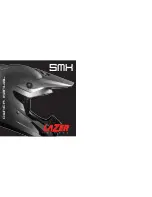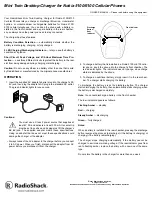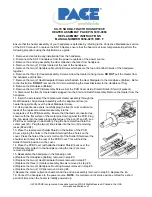
WIRING GUIDE
All wiring must be installed in compliance with the National Electrical Code,
applicable local codes, and any special requirements of the Authority Having
Jurisdiction. Proper wire gauges should be used. The installation wires should
be color-coded to limit wiring mistakes and ease system troubleshooting. Im-
proper connections will prevent a system from responding properly in the
event of a fire.
Remove power from the communication line before installing sensors.
1. Wire the sensor base (supplied separately) as shown in the wiring
diagram. (See Figure 2.)
2. Set the desired address on the sensor address switches. (See Figure 1.)
3. Install the sensor into the sensor base. Push the sensor into the base while
turning it clockwise to secure it in place.
4. After all sensors have been installed, apply power to the control panel and
activate the communication line.
5. Test the sensor(s) as described in the TESTING section of this manual.
CAUTION
Dust covers provide limited protection against airborne dust particles during
shipping. Dust covers must be removed before the sensors can sense smoke.
Remove sensors prior to heavy remodeling or construction.
FIGURE 2. WIRING DIAGRAM
2
3
1
2
3
3
1
2
1
(–)
(+)
+
-
Compatib
le
Control P
anel
CAUTION: Do not loop wire under
terminal 1 or 2. Break wire run to
supervise connections.
CLOSE LOOP OPTIONAL WIRING
Remote
Annunciator
(–)
(+)
RA
+
–
+
RA
+
–
+
RA
+
–
+
C0129-10AUS
TAMPER-RESISTANCE
Intelligent High-sensitivity Photoelectric smoke sensors include a tamper-re-
sistant capability that prevents their removal from the base without the use of
a tool. Refer to the base manual for details on making use of this capability.
SPECIFICATIONS
Operating Voltage Range:
15 to 32 VDC
Operating Current @ 24 VDC:
300 uA (one communication every 5 seconds with green LED blink on communication)
Maximum Alarm Current:
2 mA @ 24 VDC (one communication every 5 seconds with red LED solid on)
Maximum Current:
4.5 mA @ 24 VDC (one communication every 5 seconds with amber LED solid on)
Operating Humidity Range:
10% to 93% Relative Humidity, Non-condensing
Operating Temperature Range:
-10°C to 50°C
Air Velocity:
0 to 1219.2 m/min.
Height:
51 mm installed in B501AUS-W/B501AUS-IV Base
Diameter:
104 mm installed in B501AUS-W/B501AUS-IV Base
Weight:
95 g
Isolator Load Rating:
0.0063*
Applicable Standards:
AS 7240.7 and NZS4512
*Please refer to your isolator base/module manual for isolator calculation instructions.
This sensor must be installed in compliance with the control panel system
installation manual. The installation must meet the requirements of the Au-
thority Having Jurisdiction (AHJ).
GENERAL DESCRIPTION
Model 7251CPI
and 7251CPI-W
are
plug-in type smoke sensor that combines a
photoelectronic sensing chamber with addressable-analog communications
providing sensitivities from 0.02% per foot to 2% per foot obscuration for
Early Warning Fire Detection (EWFD) or Very Early Warning Fire Detection
(VEWFD).
The sensors transmit an analog representation of smoke density over a
com-munication line to a control panel. Rotary dial switches are provided
for set-ting the sensor’s address. (See Figure 1.)
FIGURE 1. ROTARY ADDRESS SWITCHES:
TENS
ONES
9
10
11
12
13
14
15
8
7
6
5
4
3
2
1 0
9
8
7
6
5
4
3
2
1 0
C0162-00
Two LEDs on the sensor are controlled by the panel to indicate sensor status.
An output is provided for connection to an optional remote LED annunciator
(P/N RA100Z).
Fire Alarm and Control panels offer different feature sets across different mod-
els. As a result, certain features of the photoelectric sensors may be
available on some control panels, but not on others. 7251CPI
and
7251CPI-W
support CLIP (Classic Loop Interface Protocol) protocol mode.
The possible features available in the photoelectric sensors, if supported by
the control panel are:
1. The sensor’s LEDs can operate in three ways—on, off, and blinking—and
they can be set to red, green, or amber. This is controlled by the panel.
2. The remote output may be synchronized to the LED operation or con-
trolled independent of the LEDs.
3. Devices are point addressable up to 1
5
9 addresses.
Please refer to the operation manual for the control panel for specific opera-
tion. The photoelectric sensors require compatible addressable communica-
tions to function properly. Connect these sensors to listed-compatible control
panels only.
Compatible bases:
B501AUS-W/B501AUS-IV.
SPACING
Pertronic recommends spacing sensors in compliance with
AS 1670.1:2015 or
NZ4512. All detectors should be spaced and installed in accordance with the
requirements of the relevant authority having jurisdiction. For specific infor
-
mation regarding sensor spacing, placement, and special applications, refer
to AS 1670.1:2015, NZ4512, or the Smoke Detector Applica
tion Guide.
I56-
7388
-000
INSTALLATION AND MAINTENANCE INSTRUCTIONS
7251CPI
and 7251CPI-W
Intelligent High-sensitivity
Photoelectric Smoke Sensors
www.pertronic.co.nz
www.pertronic.com.au
1
I56-
7388
-000




















